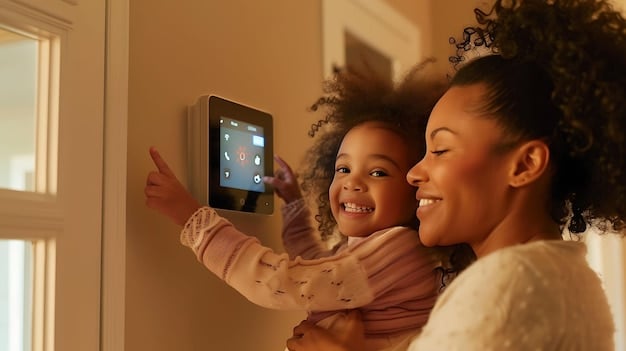Childproofing Your Smart Home: 6 Must-Know Safety Tips

Childproofing your smart home involves implementing essential safety measures like securing smart devices, monitoring systems, and adjusting settings to protect children from potential hazards and ensure a safe environment.
Creating a secure environment for your children is paramount, and this extends to your smart home. Let’s explore how to effectively **childproofing your smart home: 6 essential safety measures you can’t ignore**, ensuring peace of mind for you and safety for your little ones.
Securing Smart Devices and Preventing Access
Smart devices offer convenience, but they can also pose risks if not properly secured. Limiting access to sensitive controls and preventing accidental purchases is crucial. This involves implementing strong passwords, enabling parental controls, and physically securing devices.
Setting Strong Passwords and PINs
The first line of defense is a robust password system. Avoid default passwords and opt for complex combinations of letters, numbers, and symbols. Ensure that each smart device has a unique password to minimize the impact of a potential breach. Additionally, set up PINs for devices that control access to sensitive functions.
Enabling Parental Controls
Most smart home devices and platforms offer parental control features. These tools allow you to restrict access to certain content, limit screen time, and monitor usage. Explore the settings on your smart TVs, tablets, and smart speakers to configure appropriate safeguards.
- Limit Content Access: Filter out inappropriate websites, apps, and streaming services.
- Set Time Limits: Restrict screen time to promote healthy habits.
- Monitor Activity: Keep track of your child’s online behavior and adjust settings as needed.

Securing smart devices and preventing unauthorized access is not just about technology; it’s about creating a safe digital environment for your children. Regularly review and update your security settings to stay ahead of potential risks.
Monitoring Systems: Security Cameras and Baby Monitors
Smart security cameras and baby monitors provide an extra layer of protection, allowing you to keep an eye on your children remotely. However, it’s essential to configure these devices securely and respect privacy. Secure your Wi-Fi network and choose devices with strong encryption.
Invest in reputable brands that prioritize data security. Avoid using default passwords and enable two-factor authentication whenever possible. Regularly update the firmware to patch any security vulnerabilities.
Be mindful of camera placement. While monitoring is important, respect your children’s privacy and avoid placing cameras in sensitive areas like bathrooms or bedrooms. Communicate openly with older children about the purpose and scope of the monitoring system.
Adjusting Smart Home Settings for Safety
Smart home devices often come with customizable settings that can enhance child safety. Adjusting these settings can prevent accidents and promote a safer environment. Setting temperature limits on thermostats, limiting automation access, and managing smart lighting are key considerations.
Temperature Limits on Thermostats
Smart thermostats offer precise temperature control, but it’s essential to set limits to prevent overheating or overcooling. Configure maximum and minimum temperature thresholds to ensure that your home remains within a safe range, especially in rooms where children spend a lot of time.
Limiting Automation Access
Complex automation routines can sometimes have unintended consequences. Limit your children’s ability to create or modify automation rules. This prevents accidental activation of devices or triggering of unintended actions. Review existing automation routines to ensure they are child-safe.
Consider programming safety-focused automation routines, such as automatically turning on lights in certain areas after dark or sending alerts if a door or window is left open.

Managing Smart Lighting
Smart lights offer convenience and energy savings, but they can also pose risks if not properly managed. Ensure that light switches are accessible and easy to operate for children. Use smart lighting features to create a safe and comfortable environment, such as dimming lights in bedrooms or setting timers to turn lights on and off automatically.
Adjusting smart home settings for safety is an ongoing process. Regularly review and update your configurations to adapt to your children’s changing needs and abilities. By taking proactive steps, you can create a smart home that is both convenient and safe.
Physical Safety Measures in a Smart Home Context
While smart technology can enhance safety, it’s essential not to overlook basic physical safety measures. Covering outlets, securing furniture, and managing cords are fundamental steps to prevent accidents. Use childproof covers on all electrical outlets, especially those within reach of children.
Secure heavy furniture, such as bookshelves and TVs, to the wall to prevent them from tipping over. Use straps or brackets to anchor these items safely. Keep cords and cables out of reach of children to prevent tripping hazards and potential entanglement. Use cord organizers or cable ties to manage cords safely.
Smart sensors that detect motion, smoke, or water leaks can provide early warnings of potential hazards. Properly installed and maintained, these sensors can alert you to issues before they escalate, allowing you to take swift action to protect your children.
Educating Children About Smart Home Safety
Education is key to promoting smart home safety. Teach your children about the potential risks of smart devices and how to use them responsibly. Explain the importance of strong passwords and not sharing personal information online. Encourage them to report any suspicious activity or safety concerns.
Set clear rules and guidelines for using smart devices. Explain what types of content are appropriate and what activities are prohibited. Monitor their online behavior and provide guidance and support as needed. By empowering your children with knowledge and awareness, you can help them navigate the smart home environment safely and responsibly.
Regularly Reviewing and Updating Security Protocols
Smart home technology is constantly evolving, and so are the security threats. Regularly review and update your security protocols to stay ahead of potential risks. Update the firmware on your smart devices to patch any security vulnerabilities. Review your password policies and encourage family members to use strong, unique passwords.
Monitor your network for suspicious activity and investigate any potential breaches promptly. Stay informed about the latest security threats and best practices for protecting your smart home. By maintaining a proactive approach to security, you can minimize the risk of incidents and ensure a safe environment for your children.
| Key Point | Brief Description |
|---|---|
| 🔒 Secure Devices | Use strong passwords and parental controls. |
| 👶 Monitor Systems | Employ secure cameras and baby monitors. |
| 💡 Adjust Settings | Set temperature limits and manage lighting. |
| 🔌 Physical Safety | Cover outlets and secure furniture. |
Frequently Asked Questions
▼
Prioritize devices with access to sensitive information or control over home systems, such as smart speakers, thermostats, security cameras, and smart TVs. Secure these devices first.
▼
Update security settings at least quarterly or whenever you receive a security alert or update notification from the device manufacturer. Regular updates ensure protection against new threats.
▼
Teach them the importance of not sharing personal information online, using strong passwords, and reporting any suspicious activity to you immediately. Emphasize responsible device usage.
▼
Yes, some companies offer smart devices with built-in parental control features, such as content filtering, screen time management, and usage monitoring. Look for these when purchasing new devices.
▼
Enable voice purchasing restrictions, require a PIN for all transactions, and regularly review your purchase history to identify and prevent unauthorized purchases. Limit access to linked accounts.
Conclusion
By implementing these essential safety measures, you can create a smart home that is both convenient and secure for your children. Prioritize security, educate your family, and regularly review your protocols to ensure a safe and enjoyable environment for everyone.





